2006 Hyundai Terracan catalytic converter
[x] Cancel search: catalytic converterPage 360 of 539
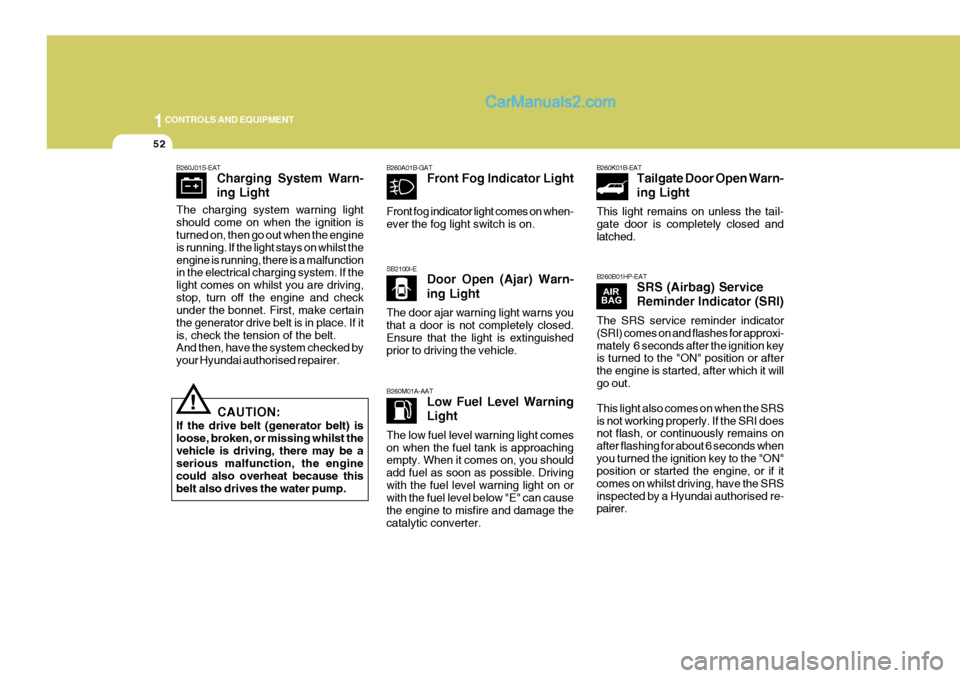
1CONTROLS AND EQUIPMENT
52
SB2100I-EDoor Open (Ajar) Warn- ing Light
The door ajar warning light warns you that a door is not completely closed. Ensure that the light is extinguished prior to driving the vehicle. B260M01A-AAT Low Fuel Level Warning Light
The low fuel level warning light comes on when the fuel tank is approaching empty. When it comes on, you should add fuel as soon as possible. Drivingwith the fuel level warning light on or with the fuel level below "E" can cause the engine to misfire and damage thecatalytic converter.
B260A01B-GAT
Front Fog Indicator Light
Front fog indicator light comes on when-ever the fog light switch is on. B260K01B-EAT
Tailgate Door Open Warn- ing Light
This light remains on unless the tail-
gate door is completely closed andlatched. B260B01HP-EAT SRS (Airbag) Service Reminder Indicator (SRI)
The SRS service reminder indicator (SRI) comes on and flashes for approxi- mately 6 seconds after the ignition key is turned to the "ON" position or after the engine is started, after which it willgo out. This light also comes on when the SRS is not working properly. If the SRI does not flash, or continuously remains on after flashing for about 6 seconds whenyou turned the ignition key to the "ON" position or started the engine, or if it comes on whilst driving, have the SRSinspected by a Hyundai authorised re- pairer.
!
B260J01S-EAT
Charging System Warn- ing Light
CAUTION:
If the drive belt (generator belt) is loose, broken, or missing whilst thevehicle is driving, there may be a serious malfunction, the engine could also overheat because thisbelt also drives the water pump.
The charging system warning light should come on when the ignition is turned on, then go out when the engine is running. If the light stays on whilst theengine is running, there is a malfunction in the electrical charging system. If the light comes on whilst you are driving,stop, turn off the engine and check under the bonnet. First, make certain the generator drive belt is in place. If itis, check the tension of the belt. And then, have the system checked by your Hyundai authorised repairer.
Page 519 of 539
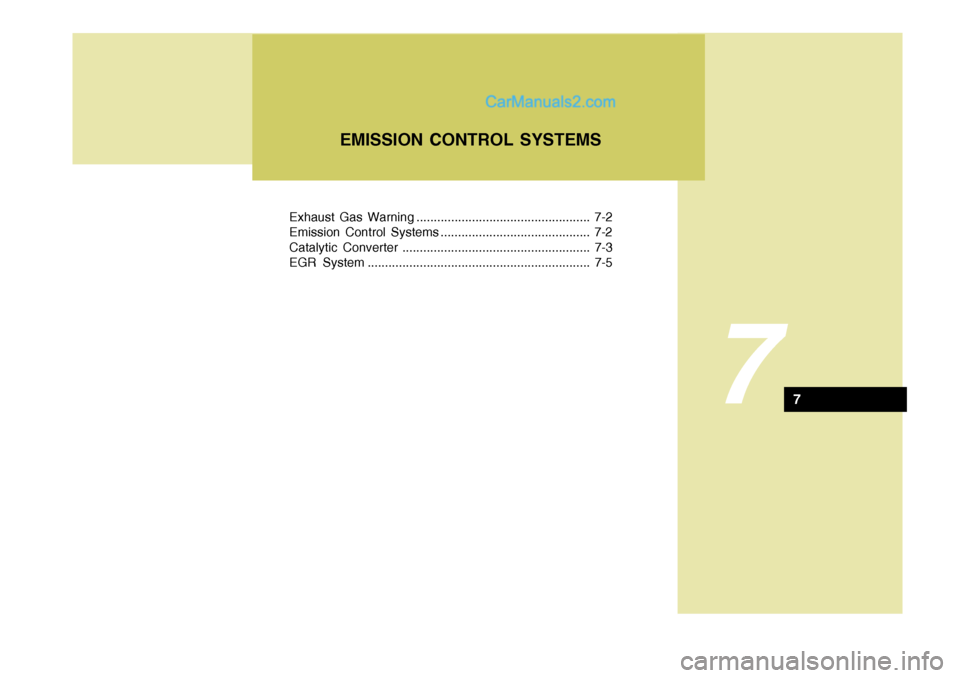
Exhaust Gas Warning .................................................. 7-2
Emission Control Systems ........................................... 7-2
Catalytic Converter ...................................................... 7-3
EGR System ................................................................ 7-5
7
EMISSION CONTROL SYSTEMS
7
Page 521 of 539
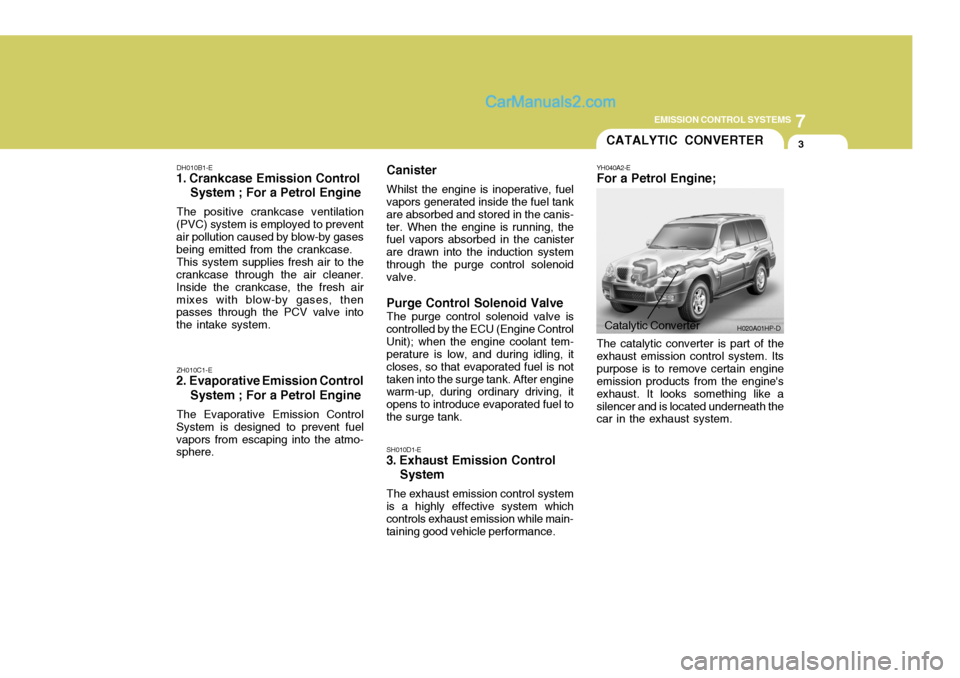
7
EMISSION CONTROL SYSTEMS
3
DH010B1-E
1. Crankcase Emission Control System ; For a Petrol Engine
The positive crankcase ventilation
(PVC) system is employed to prevent air pollution caused by blow-by gases being emitted from the crankcase.
This system supplies fresh air to the
crankcase through the air cleaner.Inside the crankcase, the fresh airmixes with blow-by gases, then passes through the PCV valve into the intake system.
ZH010C1-E
2. Evaporative Emission Control System ; For a Petrol Engine
The Evaporative Emission Control
System is designed to prevent fuel vapors from escaping into the atmo- sphere. Canister
Whilst the engine is inoperative, fuel
vapors generated inside the fuel tank are absorbed and stored in the canis-ter. When the engine is running, the fuel vapors absorbed in the canister are drawn into the induction systemthrough the purge control solenoid valve. Purge Control Solenoid Valve
The purge control solenoid valve is
controlled by the ECU (Engine Control Unit); when the engine coolant tem- perature is low, and during idling, it closes, so that evaporated fuel is nottaken into the surge tank. After engine warm-up, during ordinary driving, it opens to introduce evaporated fuel tothe surge tank.
SH010D1-E
3. Exhaust Emission Control System
The exhaust emission control system
is a highly effective system which controls exhaust emission while main- taining good vehicle performance.
Catalytic Converter H020A01HP-D
CATALYTIC CONVERTER
YH040A2-E For a Petrol Engine; The catalytic converter is part of the exhaust emission control system. Itspurpose is to remove certain engine emission products from the engine's exhaust. It looks something like asilencer and is located underneath the car in the exhaust system.
Page 522 of 539
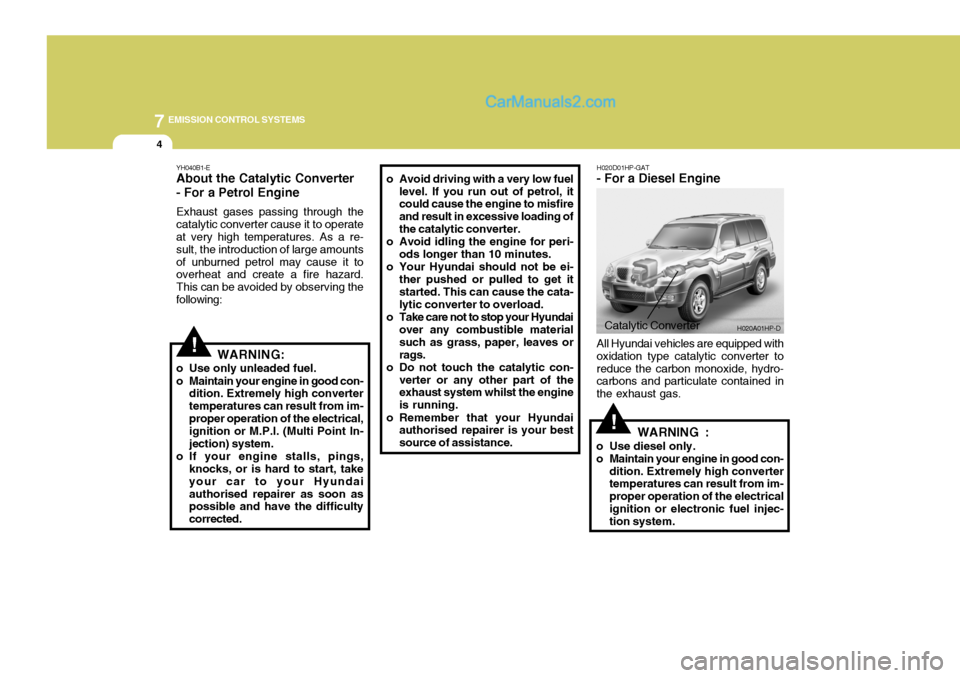
7EMISSION CONTROL SYSTEMS
4
YH040B1-E About the Catalytic Converter
- For a Petrol Engine Exhaust gases passing through the catalytic converter cause it to operate at very high temperatures. As a re- sult, the introduction of large amountsof unburned petrol may cause it to overheat and create a fire hazard. This can be avoided by observing thefollowing: H020D01HP-GAT
- For a Diesel Engine
!WARNING:
o Use only unleaded fuel.
o Maintain your engine in good con- dition. Extremely high converter temperatures can result from im-proper operation of the electrical, ignition or M.P.I. (Multi Point In- jection) system.
o If your engine stalls, pings, knocks, or is hard to start, takeyour car to your Hyundaiauthorised repairer as soon as possible and have the difficulty corrected. o Avoid driving with a very low fuel
level. If you run out of petrol, it could cause the engine to misfire and result in excessive loading ofthe catalytic converter.
o Avoid idling the engine for peri- ods longer than 10 minutes.
o Your Hyundai should not be ei- ther pushed or pulled to get itstarted. This can cause the cata- lytic converter to overload.
o Take care not to stop your Hyundai over any combustible material such as grass, paper, leaves orrags.
o Do not touch the catalytic con- verter or any other part of the exhaust system whilst the engine is running.
o Remember that your Hyundai authorised repairer is your bestsource of assistance.
Catalytic Converter H020A01HP-D
!
All Hyundai vehicles are equipped with oxidation type catalytic converter toreduce the carbon monoxide, hydro- carbons and particulate contained in the exhaust gas.
WARNING :
o Use diesel only.
o Maintain your engine in good con- dition. Extremely high converter temperatures can result from im- proper operation of the electricalignition or electronic fuel injec- tion system.
Page 523 of 539
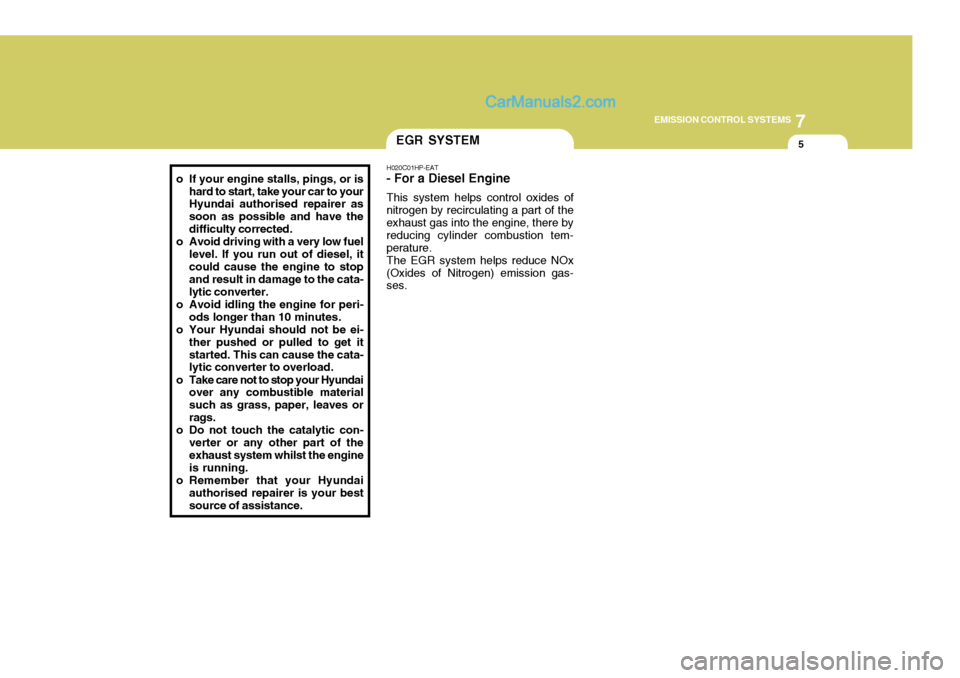
7
EMISSION CONTROL SYSTEMS
5
o If your engine stalls, pings, or is
hard to start, take your car to your Hyundai authorised repairer as soon as possible and have thedifficulty corrected.
o Avoid driving with a very low fuel level. If you run out of diesel, it could cause the engine to stop and result in damage to the cata-lytic converter.
o Avoid idling the engine for peri- ods longer than 10 minutes.
o Your Hyundai should not be ei- ther pushed or pulled to get itstarted. This can cause the cata- lytic converter to overload.
o Take care not to stop your Hyundai over any combustible material such as grass, paper, leaves orrags.
o Do not touch the catalytic con- verter or any other part of theexhaust system whilst the engine is running.
o Remember that your Hyundai authorised repairer is your best source of assistance.
EGR SYSTEM
H020C01HP-EAT
- For a Diesel Engine
This system helps control oxides of
nitrogen by recirculating a part of the exhaust gas into the engine, there by reducing cylinder combustion tem-perature. The EGR system helps reduce NOx
(Oxides of Nitrogen) emission gas- ses.
Page 535 of 539
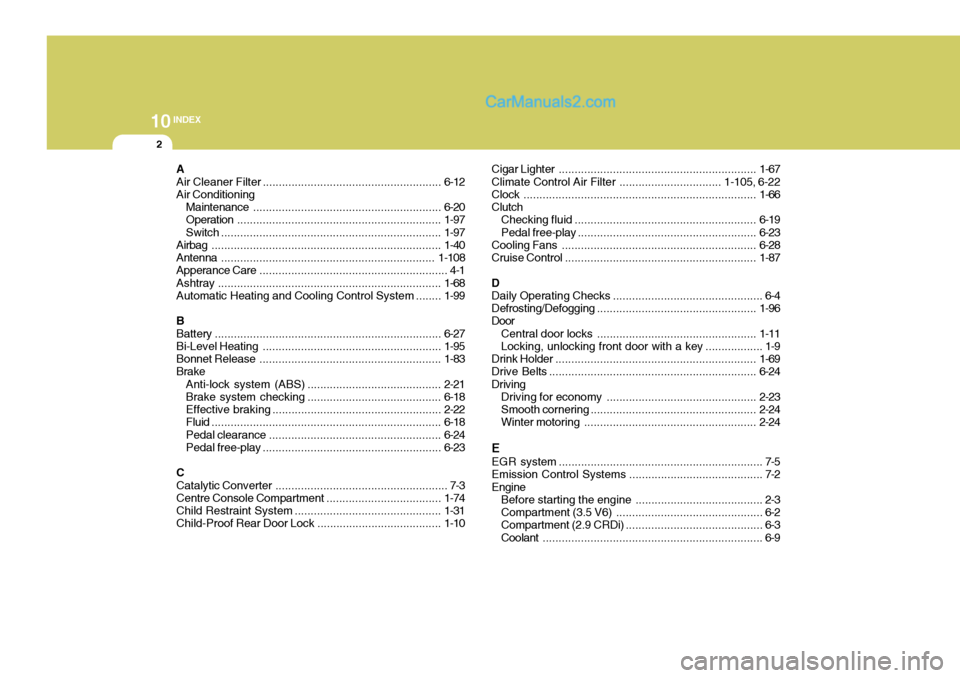
10INDEX
2
A Air Cleaner Filter ........................................................ 6-12
Air Conditioning
Maintenance ........................................................... 6-20
Operation ................................................................ 1-97
Switch ..................................................................... 1-97
Airbag ........................................................................ 1-40
Antenna ................................................................... 1-108
Apperance Care ........................................................... 4-1
Ashtray ...................................................................... 1-68
Automatic Heating and Cooling Control System ........ 1-99
BBattery ....................................................................... 6-27
Bi-Level Heating ........................................................ 1-95
Bonnet Release ......................................................... 1-83
Brake
Anti-lock system (ABS) .......................................... 2-21
Brake system checking .......................................... 6-18
Effective braking ..................................................... 2-22
Fluid ........................................................................ 6-18
Pedal clearance ...................................................... 6-24
Pedal free-play ........................................................ 6-23
CCatalytic Converter ...................................................... 7-3
Centre Console Compartment ....................................1-74
Child Restraint System .............................................. 1-31
Child-Proof Rear Door Lock ....................................... 1-10Cigar Lighter
.............................................................. 1-67
Climate Control Air Filter ................................ 1-105, 6-22
Clock ......................................................................... 1-66
Clutch Checking fluid ......................................................... 6-19
Pedal free-play ........................................................ 6-23
Cooling Fans ............................................................. 6-28
Cruise Control ............................................................ 1-87
D Daily Operating Checks ............................................... 6-4
Defrosting/Defogging .................................................. 1-96
Door
Central door locks .................................................. 1-11
Locking, unlocking front door with a key .................. 1-9
Drink Holder ............................................................... 1-69
Drive Belts ................................................................. 6-24
Driving Driving for economy ............................................... 2-23
Smooth corneri ng .................................................... 2-24
Winter motoring ...................................................... 2-24
E EGR system ................................................................ 7-5
Emission Control Systems .......................................... 7-2 Engine Before starting the engine ........................................ 2-3Compartment (3.5 V6) .............................................. 6-2
Compartment (2.9 CRDi) ........................................... 6-3
Coolant ..................................................................... 6-9